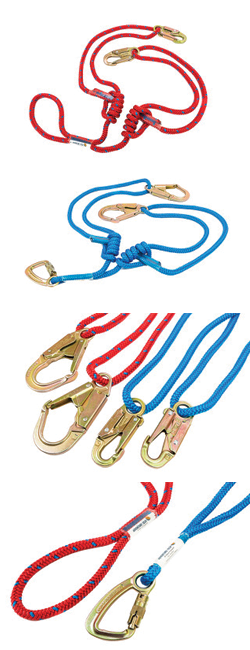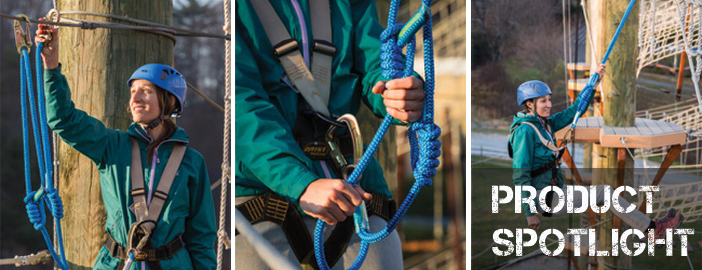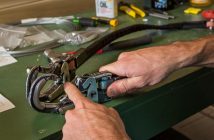On traditional high ropes and challenge courses, “lobster claws,” or Y-lanyards, remain a favorite safety lanyard because they allow for participant engagement and freedom of movement. Y-lanyards are also economical due to a low initial cost and low cost of ownership over time. Because they do not prevent accidental unclipping from the belay cable, though, a high level of participant supervision is required.
But people love the classics, and these hitch-adjusted Y-lanyards are a favorite for two reasons:

The Y Lanyard from Aerial Adventure Tech
- Ease of adjustability for the participant: adjusting the lanyard length with the sliding hitches allows the participant to tailor the challenge to themselves—making the lanyards shorter when they need more tension, and longer to provide more challenge on the element. The lobster claws can also quickly be adjusted to limit fall distance on the element.
- The ability to adjust the lanyard under load: this is critical when transferring participants to a rescue system. When the participant is ready to be lowered, the knots can be slid upwards to transfer the load onto the rescue system and remove the participant from the belay cable.
From a design and function standpoint, y-lanyards, when used properly, are terrific for traditional applications. In the past, it was the construction that ultimately led to them having a poor reputation.
Spliced, Three-Strand Lobster Claws
Hand-spliced lobster claws made of three-strand Multiline rope were the industry norm for a long time. They performed well, but presented certain issues as our industry moved into a more organized, regulated environment. Among them:
- The rope being used, while plenty strong, most often was not rated by the manufacturer for life safety use.
- These were hand-spliced in house by either course operators or builders. Almost uniformly, there was no third party testing or quality control in the manufacturing process. In addition, there was no serializing or batch tracking of lanyards, so if the equipment failed it would be very hard to track the root issue.
- The three-strand construction and hand-spliced terminations had the tendency to pick and become unraveled, resulting in early retirement or, unfortunately, lanyards continuing to be used when they shouldn’t.
For these reasons, many trade organizations, standards bodies, and course builders have encouraged operators to transition away from these lanyards. However, there’s a new solution.
The Modern Alternative
Operators still love the usability and durability of the spliced lobster claws, but they are being encouraged to remove them from use. So what to do? Aerial Adventure Tech has designed the Easy Adjust Y Lanyard—a solution that keeps the classic design, and has modern features to meet current standards and recommendations.
Here is how we addressed some of the pain points the industry is facing:
- All components (rope and connectors) are rated for life safety use.
- Grippy, solid braid rope cuts down on weight and bulk, but still provides the same performance as the three strand rope. The solid braid construction also makes the rope easy to inspect.
- Machine sewn terminations prevent unraveling of the termination and provide quality control.
- Highly trained splicing experts do the manufacturing in a specialized facility.
- Thorough labeling includes manufacture date and serial number for manufacturing lot tracking, and your own on-site equipment tracking.
- The product has been tested to, and exceeds the ANSI Z359 requirements for adjustable positioning lanyards.
- Hitch wrap design provides the classic ease of adjustment, while gripping tight in the event of a fall.
In addition, we included some features to meet the varied needs of a high ropes course:
- Two harness connection options: a carabiner attachment for quick removal of lanyards when moving to a different activity, and a girth hitch option for more permanent attachment to the harness.
- Two top connector options: small snap hooks for normal high ropes use, or larger snap hooks for racking the hooks over a trolley when zip lining.
- Two color ways: classic red and blue will keep your gear looking clean.
This product spotlight advertorial has been sponsored by Aerial Adventure Tech.





